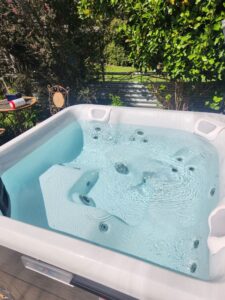Waking up and breathing in plants is probably the most ideal way to start your morning. They help freshen the air and can do all kinds of other things, including reducing stress and anxiety, improving sleep, and reducing your blood pressure. You can also add plants to your bedroom to make it more comfortable, stylish, lower noise, and absorb odours.
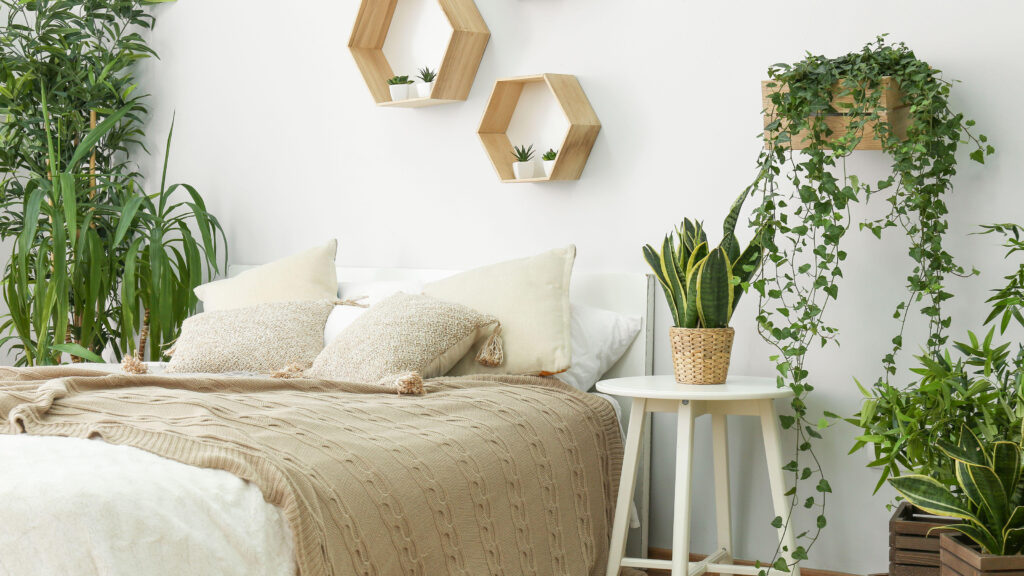
To make sure you choose the best plants for your needs, here are five factors you should consider:
The Light
You first need to consider the amount of light in your bedroom. If your bedroom doesn’t get much sunlight, you need to stick with plants that don’t require as much.
The Aloe Vera plant is a good option as they do well in shady areas. Not only will these bring some colour to the room, but the gel inside the leaf can also be used to soothe any burns or rashes, heal wounds, and correct dandruff.
Studies have also shown that adding a snake plant to your room can reduce the number of toxins in the air and increase the oxygen in the room. Snake plants also don’t require a lot of maintenance and don’t need to be watered often.
The Temperature
Another thing to consider is the temperature of the room. If your room gets particularly cold in the winter or particularly hot in the summer, you’ll want to add plants accordingly.
If your room gets cold, you’ll want to add some plants that can help keep the room warm. Plants like the Boston Fern or the Areca Palm Do very well in cool environments and can help maintain the room’s temperature, so you don’t have to rely on your heater as much.
On the other hand, if your room gets hot, you’ll want to add plants that will evaporate well in the heat and help cool down the room. Plants like the Aloe Vera and the Snake Plant can help absorb heat and trap moisture that can then evaporate, cooling the room.
The Size
When choosing plants for your bedroom, you also have to consider the size of your room. If it’s a smaller room, you’ll only want to add a few plants as it can get crowded quickly. If it’s a bigger room, you can add more plants and experiment more.
If you have a smaller room and want to add some plants, you’ll want to stick with small plants that can sit easily on the furniture or a windowsill. If it’s too crowded, it can cause those plants not to thrive.
On the other hand, if you have a larger room, you can experiment a bit more with the plants you include. For example, you can layer different plants or include larger plants like a palm tree or Money Tree.
The Pollution
If you live in a particularly polluted area, you’ll want to include plants that actually help purify the air.
One of the best plants for reducing pollution is the Snake Plant, as it’s been shown to help remove toxins from the air, like formaldehyde and carbon dioxide and replace them with oxygen.
Studies have also shown that the Areca Palm can remove toxins from the air 50% more efficiently than other common plants, making them a good option for heavily polluted areas.
The Room
You will need to pay attention to the plants you include. You don’t want your space to look too busy or cluttered, so make sure the plants will fit in with the rest of the room. Indoor plant arrangements can be a good way to bring colour without taking up too much space.
If your room is quiet and relaxing, you’ll want plants that complement that. Any plants we’ve already mentioned are appropriate, but you can also consider adding chrysanthemums or hibiscus plants.
6 Plants that Can Meet your Requirements
Aloe Vera
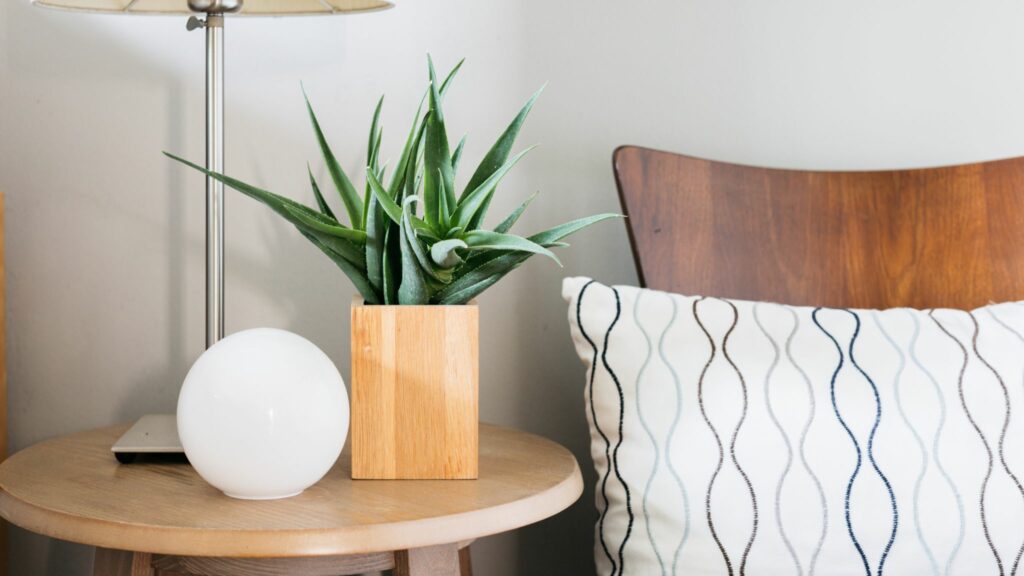
With its unique triangular-shaped leaves, aloe vera is one of the most distinctive plants in the world. It’s also one of the most beneficial, as the gel inside these leaves can be used to treat many minor ailments, including sunburn, small cuts and insect bites.
Aloe vera, however, is also a beautiful plant. Its leaves have a vivid and exciting green hue, but aloe vera is also known for its white, orange, yellow and pink blooms.
While not technically the easiest plant to maintain, with the proper care, your bedroom could end up showing off beautiful blooms. Aloe vera helps to clean the air in your bedroom of some toxic chemicals.
If you keep your aloe vera on the windowsill, it will receive adequate sunlight and also help to combat indoor pollutants such as benzene and formaldehyde. But, if you have pets or children, you may want to keep it out of their reach because the leaves and blooms of aloe vera contain saponin, a toxic substance to pets such as dogs and cats.
How to Maintain your Aloe Vera Plant
To look after your aloe vera plant at home, keep it in a bright spot that receives indirect sunlight. Water the plant when the soil is dry to the touch, and be sure to fertilise it every few months.
Areca Palm
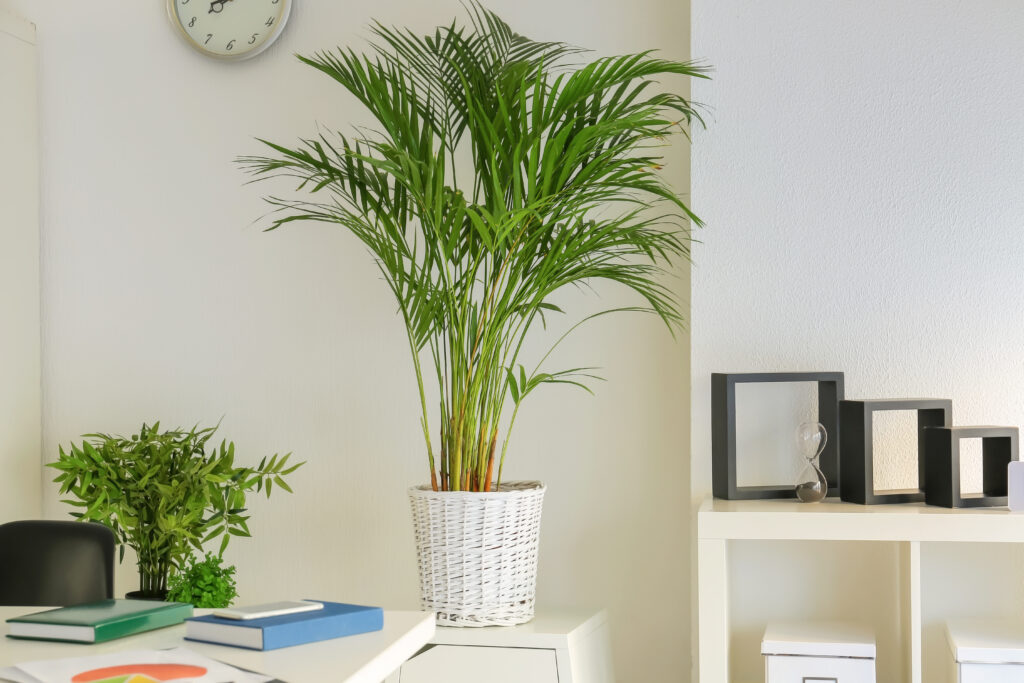
Areca palm is a stunning plant with lush, graceful fronds and a graceful and slender stance. It’s also a speedy grower, going from about two feet in height to about five feet in just a few years.
This palm category grows best in sunshine but will still thrive in some shade. Because it loves to spread its roots and grow, areca palms can become troublesome if not pruned at least once a year. Other than that, areca palms are not too demanding when it comes to plant care.
Areca palm clears toxins Areca palms are known to be especially helpful when it comes to cleansing the air of various and sometimes dangerous chemicals, such as trichloroethylene and xylene.
Because the palm fronds are so broad, they also help purify a large quantity of air. You can keep areca palms in your bedroom or any other room of your house if you’re interested in better air quality.
However, be mindful of your pet’s paws because if your cat or dog eats any part of an areca palm, the inside of their gut will be lined with poisonous fibres.
How to Maintain your Areca Palm
They are easy to look after and only need to be watered when the soil is dry to the touch. They like bright, indirect light but can tolerate some shade. Keeping the palm away from draughts is crucial as this can cause the leaves to turn brown.
Areca palms are also sensitive to chemicals, so it is best to use organic methods to fertilise and control pests.
Boston Fern
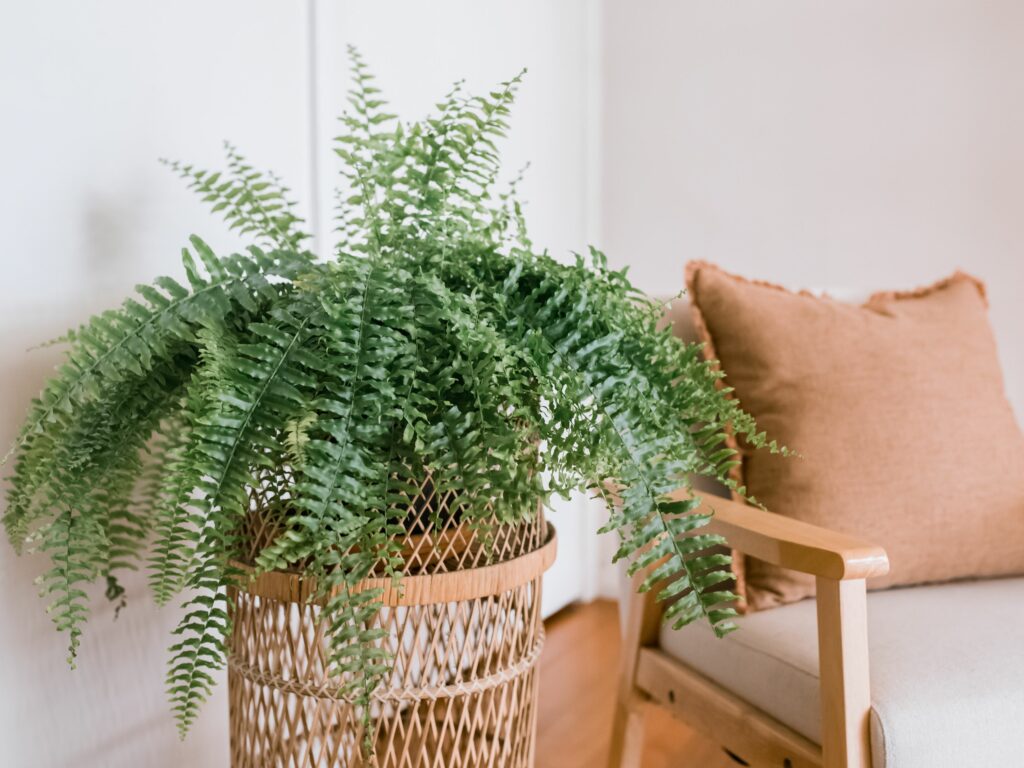
From a distance, you may mistake a lush Boston fern for a wall of grass. As Boston ferns can get pretty big, you may want to invest in an extra-large pot to keep this plant happy.
Boston fern helps respiratory and skin disorders and has the unique ability to remove many toxins and chemicals from the air. They’re known to be especially good at removing toxins such as formaldehyde and other irritants that can trigger breathing troubles, such as asthma and allergies.
Placing Boston ferns throughout your house may make things a little easier if you or someone in your family suffer from respiratory issues. Boston ferns are also known to help combat acne and other skin disorders.
How to Maintain your Boston Fern
To look after your Boston fern, water it lightly every couple of days. Ferns like to be moist but not soggy, so be careful not to over-water.
Fertilise your fern every few weeks with a half-strength solution of all-purpose fertiliser. Ensure you trim off any brown or yellow leaves as they appear.
Place your fern in bright, indirect light. Too much sunlight will scorch the leaves. Boston ferns are sensitive to drafts, so keep them away from heaters, vents, and doors. If your fern looks tired or sickly, move it to a humid spot, such as a bathroom or kitchen.
Chrysanthemum
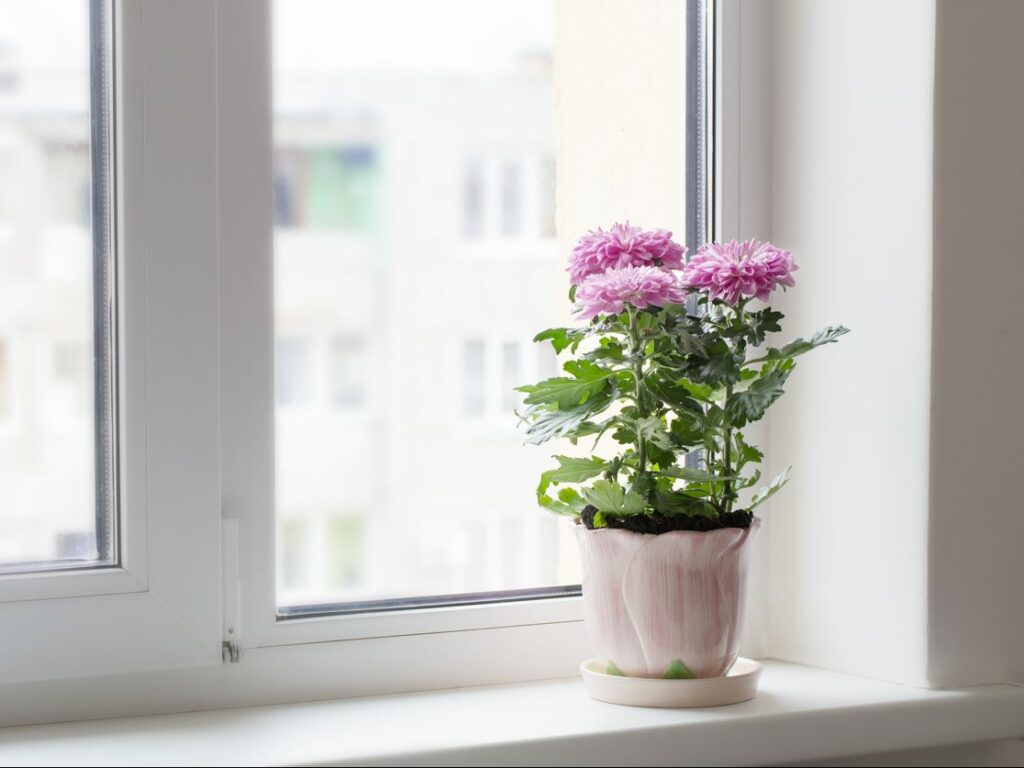
Chrysanthemum is a bright and cheery flower that can last as long as twelve weeks. While still technically a flower, Chrysanthemums have various colours such as white, pink and red. They make ideal house plants because they’re cheerful and vibrant and tend to blossom long before other plants.
But your flower won’t last forever, so when it comes to removing it, you can still have an attractive pot to show off by placing smaller plants in it.
Chrysanthemums help with headaches and are especially good at filtering air toxins such as mould and bacteria. Chrysanthemums are also well-known for being anti-inflammatory and anti-microbial.
If you or someone in your house suffers from migraines and other types of headaches, you may want to keep a couple of chrysanthemum plants in your bedroom because fresh air and natural sunlight are well-known remedies for migraines. Chrysanthemum is also renowned for being anti-inflammatory and anti-microbial.
How to Maintain your Chrysanthemum
First, you need to make sure that the plant gets enough sunlight. It is best to place the plant where it will get six to eight hours of sunlight daily. If you cannot provide this much sunlight, you can set the plant in a north-facing window.
Second, you must ensure that the plant is getting enough water. The soil should be kept moist but not soggy. To water the plant, you can use a watering can. Water the plant once a week or when the soil feels dry to the touch.
Third, you need to fertilise the plant. You can use a balanced fertiliser that is made for flowers. Apply the fertiliser to the soil around the plant every six weeks.
Fourth, you need to deadhead the plant. This means that you need to remove the dead flowers from the plant. To do this, you can use scissors and cut off the dead flowers at the stem.
Finally, you need to prune the plant. You need to cut back the plant to encourage new growth. You can do this in the spring or the fall.
Dracaena
While there are more than forty varieties of dracaenas, all dracaenas are known for their slender statures and signature leaves. Some types have bold jewel-tone stripes on their leaves, while others will be a solid green or a more muted dark green.
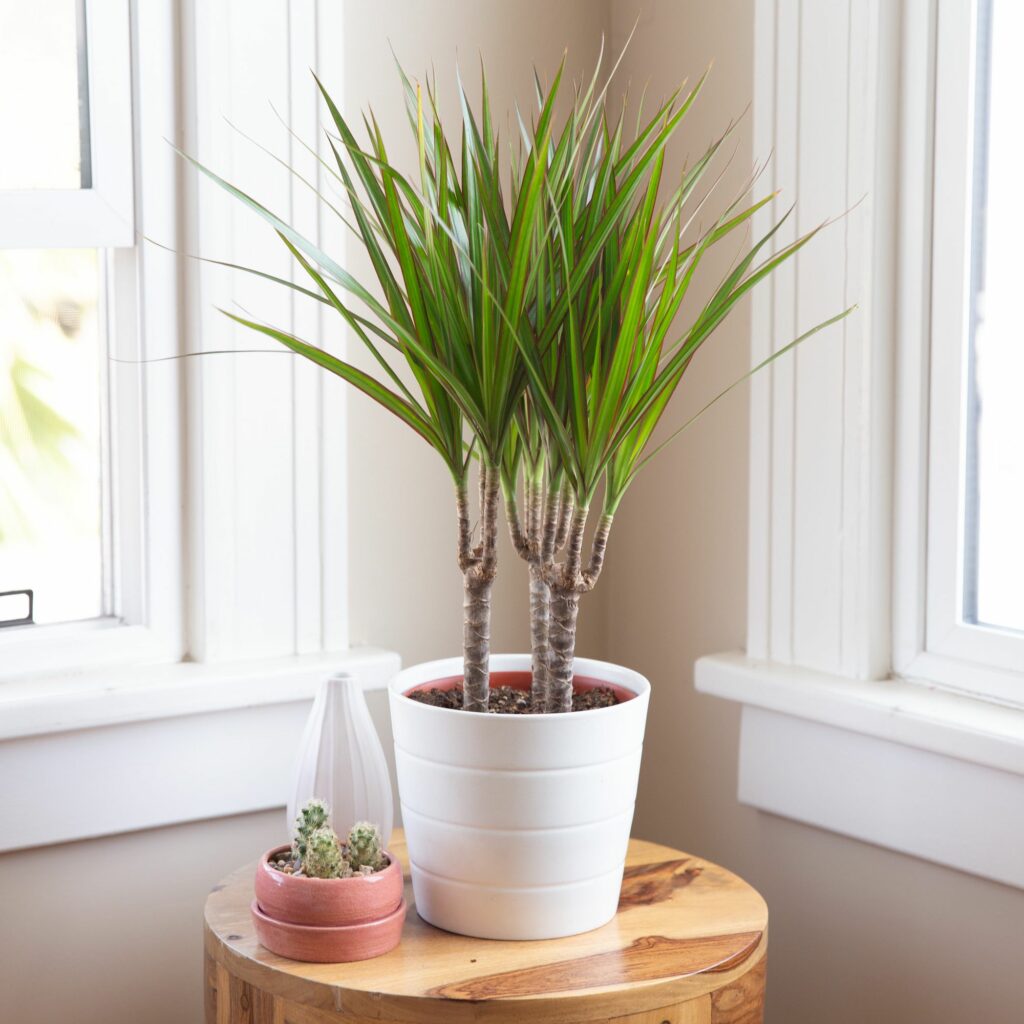
Dracaenas can grow to six feet in height, but they can be pruned to maintain a smaller size. They love the sun but will endure some shade just fine. You can even keep a dracaena in your bathroom, as they also enjoy high humidity.
Dracaena actively removes toxins from the air by absorbing toxins on the surface of the leaves and plant and storing them in the plant. The plant doesn’t wholly digest these toxins but only holds what it can’t handle.
Dracaena is beneficial at removing toxins like trichloroethylene and xylene, so if you’re concerned about the potential for cancer, investing in a dracaena is an excellent way to protect yourself.
How to maintain your Dracaena
Dracaena Marginata will grow best in bright, indirect light but can tolerate low light conditions. It is essential to avoid direct sun, which can scorch the leaves.
Allow the top few inches of soil to dry out between watering—water less in winter when the plant is dormant. Overwatering can cause root rot.
Fertilise monthly during the growing season using a balanced liquid fertiliser. Do not fertilise in winter. Dracaena can be pruned to control its size and shape. Pruning will also encourage new growth.
Dracaena Marginata prefers warm temperatures and will not tolerate cold drafts. This plant prefers humid conditions but will tolerate dry air. Mist the leaves occasionally to raise the humidity around the plant.
Snake Plant
A snake plant is a perfect addition to any home – whether you’re a plant lover or not.
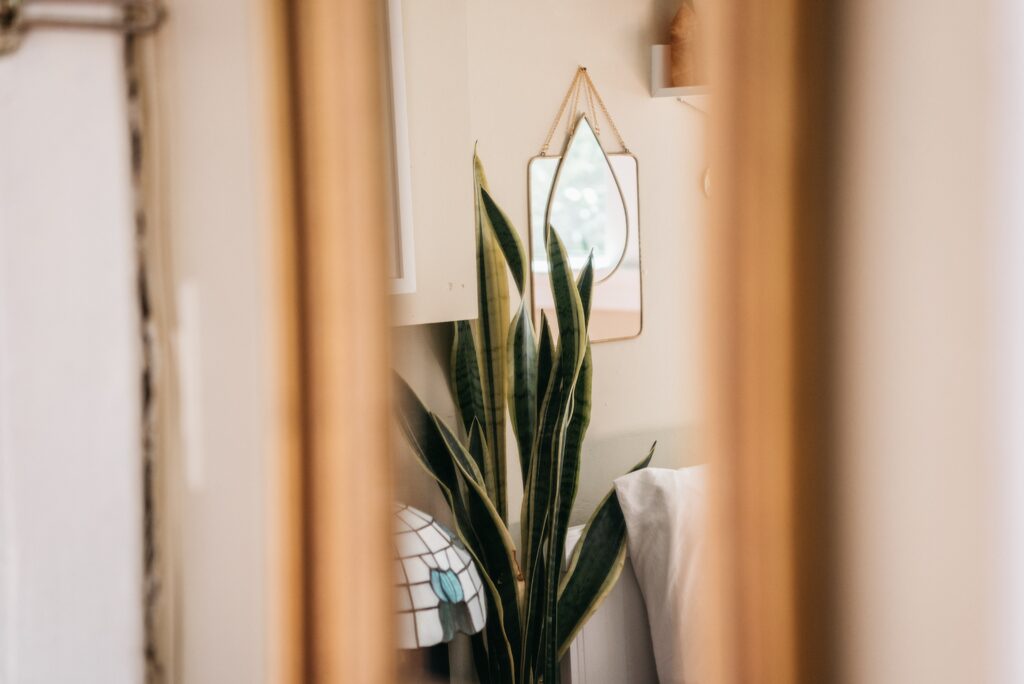
Snake plants are virtually indestructible. If you’re looking for a low-maintenance plant and practically impossible to kill, a snake plant is a great option. These hardy plants can survive in various conditions, from low-light rooms to hot, dry climates.
Snake plants are known for improving indoor air. These plants absorb harmful toxins like formaldehyde and carbon dioxide and release oxygen into the air.
Snake plants are low-allergy. A snake plant is a good option if you’re allergic to pollen or other plant-based allergens. These plants produce very little pollen, making them much less likely to trigger an allergic reaction.
The snake plant is stylish with sleek, upright leaves. The plant makes a stylish addition to any room. These plants come in various colours and variegations, so you can find the perfect one to match your décor.
Snake plants can help you sleep. If you have trouble sleeping, a snake plant may be able to help. These plants release oxygen at night, which can help you sleep more soundly.
A snake plant is a good choice for your home if you have pets. These plants are non-toxic to dogs and cats, making them safe for your furry friends.
How to Maintain your Snake Plant
Very little maintenance is required for a snake plant. To keep your snake plant healthy, water it when the top 1-2 inches of soil are dry and give it bright, indirect light.
If the leaves start to droop, it’s an indication that the plant is thirsty. It’s important not to over-water a snake plant because too much water can lead to root rot. When you water the plant, make sure the water drains out completely and isn’t sitting in the pot.
To remove dust from the leaves, wipe them down with a damp cloth or give them a light misting. You can also put the snake plant in the shower and let the water run over it for a deeper clean.
Fertilise your snake plant once a month during the growing season with a basic houseplant fertiliser. Be sure to follow the directions on the packaging.
Conclusion
Growing plants in your bedroom can liven up the look of your space and make your air cleaner, fresher, and often more humid. You can grow various plants that you can either move to your deck or patio in the summer or leave indoors to enjoy year-round. Plants can also make wonderful presents for family and friends, who may appreciate the organic beauty. The plants mentioned above can be found at many garden centres near you.







